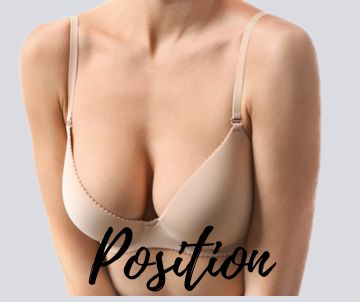Male-to-Female Breast Augmentation
Embrace Your True Self with Breast Augmentation in Montreal and Live Life to the Fullest
For many, breast size is integral to feeling healthy, attractive, and confident. If the breasts you desire aren’t naturally yours, breast augmentation may offer the ideal solution.
Male-to-Female Breast Augmentation Journey
Empowering Authenticity: Your Journey, Your Body, Your Choice

Male-to-female breast augmentation surgery is a pivotal milestone for transgender individuals on their journey to align their bodies with their gender identity. This transformative procedure, also known as MTF breast augmentation, involves enhancing breast size and shape through implants. As someone exploring this option, it’s vital to access reliable information and support.
The World Professional Association for Transgender Health (WPATH) has established guidelines that cover various factors, including psychological readiness, medical eligibility, and understanding the effects of surgery on reproduction.
Organizations like WPATH are instrumental in advocating for transgender healthcare rights and establishing standards of care. By seeking guidance from resources like WPATH, individuals can navigate their journey with confidence and empowerment. If you want to learn more about WPATH surgical criteria, please read the section below.
Gender-Affirming Breast Augmentation – The Essentials
Book a consultation now to explore breast implant options, from techniques to financing. We look forward to helping you decide whether breast implants are right for you.
Feminization Breast Augmentation

Based on the criteria set by the World Professional Association for Transgender Health (WPATH) for gender-affirming surgery, several factors must be taken into account before moving forward with surgical intervention:
- Individual must consistently feel their gender doesn’t match their body
- Meets diagnostic criteria for gender incongruence before gender-affirming surgery.
- Shows capacity to consent for the specific surgical procedure.
- Understanding the effects of surgery on reproduction and exploring available reproductive options.
- Identify and exclude other potential causes contributing to perceived gender incongruence.
- Evaluate mental and physical health conditions that might influence surgical results and discuss the associated risks and benefits.
- Stable on their gender-affirming hormonal treatment regime.
When you are planning for a breast augmentation, you should think about these key items:
- Research surgeons experienced with transgender patients.
- Understand the procedure and potential outcomes.
- Discuss hormone therapy impact with healthcare provider.
- Set realistic expectations with the surgeon.
- Determine and plan for the surgery’s cost.
- Follow pre-operative instructions for optimal results.
- Build a support system for emotional support.
- Arrange post-operative care and assistance.
- Seek mental health support if needed.
- Attend follow-up appointments for monitoring and guidance.
Male-to-female transgender breast augmentation is commonly performed under general anesthesia and takes about an hour to complete. During the procedure, the surgeon will make incisions either around the areola, in the inframammary fold, or in the axilla (armpit), depending on your anatomy and implant type. The implants are then carefully inserted into the breast pocket, and the incisions are closed with sutures.
Following surgery, you will need to take some time off work and limit physical activity to allow your body to heal properly. Your surgeon will provide post-operative instructions, including how to care for your incisions, manage discomfort, and gradually resume normal activities. It’s important to attend follow-up appointments to monitor your progress and address any concerns that may arise.
Several types of breast implants are available, each with unique characteristics. Two options include saline implants and silicone implants.
Saline implants are filled with saltwater solution, while silicone implants are filled with silicone gel. Each type has its own benefits and considerations, and the choice depends on factors like desired outcomes and personal preferences.
During your consultation, your surgeon will help you choose the type, size, and shape of implants that best suit your anatomy and aesthetic goals.
Breast Augmentation Techniques

For individuals transitioning and considering breast augmentation, it’s important to understand the different implant pocket options. A subglandular, submammary, or retroglandular placement involves creating a pocket over the chest muscle by elevating the mammary gland. This approach offers advantages such as reduced pain, enhanced projection, and implants that remain stable during pectoral muscle contraction. It’s ideal for individuals with ample breast tissue opting for silicone implants. However, the implant may be more visible and palpable under thin breast tissue, making it less suitable for those with thinner breast tissue or choosing saline implants.
For transgender women seeking breast augmentation, the more common approach involves creating a pocket under the chest muscle, known as submuscular, subpectoral, dual plane, or retropectoral breast augmentation. This technique involves placing the implants between the major and minor pectoralis muscles. Benefits include improved implant coverage, reducing the visibility of rippling and palpability. This approach is particularly suitable for thinner breast tissue patients or those opting for saline implants. However, drawbacks may include substantial postoperative pain and potential implant displacement with pectoral muscle contraction.
In August 2011, Dr. Chen Lee introduced the use of the “Keller Funnel” into his breast augmentation practice, offering advantages such as a no-touch technique, reduced stress on the implant’s outer shell, shorter skin incisions, and minimized tissue trauma. The Keller Funnel facilitates precise implant insertion, reducing contamination risk and potential complications like capsular contracture. Patients can expect improved aesthetic outcomes, making the Keller Funnel a valuable addition to breast augmentation procedures.
Inframammary Incision:
The inframammary incision is the most common incision used for breast augmentation. This incision is located in the crease where the breast meets the chest and leaves a well-concealed scar below the breast. Direct visual access to the implantation site facilitates accurate breast implant placement with a low likelihood of malpositioning and asymmetry. All sizes of breast implants can be surgically positioned through an inframammary incision. This incision is particularly suitable for larger-sized silicone breast implants.
Periareolar Incision:
The periareolar incision is located on the lower border of the pigmented skin surrounding the nipple (lower margin of the areola). A natural pigmentation change between the areola and normal skin serves to camouflage and conceal the resulting breast augmentation scar. This access incision also permits direct visualization of the surgical pocket for final silicone breast implant placement. The length of the periareolar incision is limited by the circumference and size of the areola. Not all sizes of silicone breast implants can be placed through this incision.
Transaxillary Incision:
The transaxillary incision is hidden in the armpit and is remotely located from the breast. A collapsible saline breast implant is preferred with this incision. The smaller dimension of the deflated saline breast implant facilitates its positioning through the tight confines of this remote incision. The implant is filled at surgery only after manipulation into its desired position. Modest or smaller-sized prefilled silicone smooth breast implants can also be positioned through the transaxillary incision. Direct surgical access for pocket creation is not possible. The creation of a well-contoured symmetric lower breast pole remains a problem with remote transaxillary access. The resulting scar in the armpit might be visible with sleeveless attire. Women who often wear sleeveless apparel might consider another choice of incision for their breast augmentation.
Breast Implant Cost

$165.25 + taxes
The initial consultation for breast augmentation is a wonderful opportunity to establish a strong patient-surgeon relationship. During this session, your plastic surgeon will conduct an examination, provide personalized recommendations, discuss risks, and address any concerns. It’s a chance for patients to evaluate the surgeon’s expertise and communication style while ensuring their goals are understood.
$10,800 + taxes
The price of breast augmentation in Montreal is quoted as a “global fee”. The price quote includes costs of the surgeon, anesthesiologist, nurses, breast implants, office visits during the first postoperative year, operating room, and surgical facility fees. Revisions and touch-up surgeries are not included in the initial breast augmentation quotation. If general anesthesia is necessary, you will have to pay for the substantial costs associated with a surgical revision. Minor touch-up surgery under local anesthesia can often be performed at minimal expense. The customary price of breast augmentation in Montreal is $10,800 + taxes.
Surgeries are payable in cash, certified checks (bank drafts) or Interac. We also work with an independent credit company that offers financial payment plans for cosmetic surgery procedures. However, you should be aware that the interest rates and administration fees of this specialized company are higher than traditional financial institutions. It is often better to negotiate a loan through your personal bank or financial institution. We encourage you to do your homework and compare the true financial cost of these various financial options.
Scheduling your breast augmentation is a 3-step process.
Step 1: Reservation Date for Surgery
Our office staff works diligently to schedule surgeries to your availability and preference. However, operating room resources are precious and a financial commitment is necessary to reserve a dedicated time. Half of the surgical fee is due upon reservation of dedicated operating room time for your breast augmentation. Full payment is due 2 weeks before the day of surgery.
Step 2: Breast Implant Sizing
Once your surgery is scheduled, our office will work with you to choose the ideal breast implant size for your body. This often requires several in-office visits where you are able to place implant sizers under clothing to simulate the results expected. It often helps to have a family member or friend present during your breast implant sizing visits. Breast implant sizes must be chosen well before surgery so that we have sufficient time to order and have your preferred breast implant sizes available at the surgery.
Step 3: General Health Evaluation
Breast augmentation is performed under general anesthesia. To ensure your safety, a general physical examination and laboratory tests are performed. During your preoperative visit, our breast surgeon will obtain standardized medical photos and provide general instructions on preparation for surgery and pain management.
FAQ – BREAST AUGMENTATION
It is natural to have concerns and questions regarding breast implant safety. Dr. Chen Lee is committed to helping you understand the risks to make an informed decision about breast augmentation.
MTF Individuals who desire to achieve a more feminine chest contour and have undergone hormone therapy, are 18 years old or older, are physically healthy, emotionally stable, and have realistic expectations of what plastic surgery can accomplish are likely good candidates for breast augmentation.
The best way to determine if a breast augmentation is appropriate for you is to meet with a reputable board-certified plastic surgeon.
There are two main types of breast implants: saline and silicone. Your surgeon will discuss these options with you and help you choose the one that best fits your desired body type.
About 3 weeks before surgery, and based on factors like your health, family history, and environment, you may need to stop taking feminizing hormones. This helps minimize complications and risks during and after surgery. Your surgeon will provide guidance and further information if this applies to you.
While the anticipated change expected with breast augmentation is exciting, it is important to be aware of the risks and potential complications. Surgery and general anesthesia are always accompanied by some risks to your general health. Although rare, there even exists the possibility of death.
A partial list of potential complications associated specifically with breast augmentation includes asymmetry, deformation, infection, bleeding, delayed healing, reoperation, implant visibility, implant palpability, pain, loss of sensation, scars, capsular contracture, implant rupture, implant malposition, and no guarantee to the final size.
Following breast augmentation, patients often experience temporary loss of erotic and general sensitivity to the breasts and nipples. In most instances, normal sensation returns spontaneously and naturally over time.
Recovery is different for everyone. In general, most women can get up and walk alone the day after surgery. However, it is important to avoid most of your usual activities such as cooking, cleaning, carrying weight (groceries or children), and driving for 7 to 14 days. You will be advised to wait several weeks before resuming exercise.
We strongly recommend a minimum of 2 weeks away from work. On occasion, some patients may be able to return to light nonphysical work (e.g. office) 7 to 10 days after breast augmentation. Every patient’s experience is unique. The size and position of implant placement may affect the above recommendations.
Modern breast implants are expected to last for many years. However, the actual long-term durability has not been scientifically defined. While many patients believe that their breasts are permanently augmented with a single surgery, implantable synthetic prostheses should not be considered lifetime medical devices. All synthetic implantable medical devices (such as heart valves, brain shunts, orthopedic joints, and breast implants) can malfunction and fail.
While the risk of breast cancer is not elevated following breast augmentation, screening is still necessary and encouraged. Common methods for detecting breast cancer include mammography, ultrasound, and magnetic resonance imaging (MRI). Mammograms can still be performed, however, modified techniques such as breast compression to enhance the view of the breast tissue is often necessary for an effective breast mammogram. To better plan, your breast investigations, the physician managing your breast cancer prevention routine should be made aware of your breast augmentation.
In 2017, Health Canada initiated a review of Canadian cases of rare cancer associated with textured surface breast implants. This entity is known as breast implant-associated anaplastic large cell lymphoma (BIA-ALCL). It is lymphoma and not breast cancer. BIA-ALCL develops in the scar tissue around a breast implant. The incidence is low. The majority of cases have been associated with textured surface breast implants. To date, scientific reports indicate favorable outcomes when affected patients are treated by breast implant explantation with surgical excision of the surrounding capsule. As of 2019, the national consensus on treatment is to surgically remove the implant and its surrounding scar without delay in any woman developing BIA-ALCL.
Textured surface breast implants were removed from the Canadian market in May 2019.
Breast Augmentation Price
- $10,800 + taxes
- Includes professional fees (surgeon, anesthesiologist, and nurses)
- Includes the surgical facility and operating room expenses
- Includes silicone or saline-filled breast implants
- Revisions and touch-up surgeries are not included
Preparation for Breast Implants
- Avoid nonsteroidal anti-inflammatory medications (Aspirin, Advil, etc.)
- Stop smoking, do not use e-cigarettes, avoid nicotine and marijuana
- Do not drink alcohol
- Continue prescription medications (unless advised otherwise)
Day of Surgery
- Stay fasted from midnight prior to surgery (no food, no drinks)
- Be punctual – Arrive on time at the surgery facility
- Wear loose clothing – Avoid the use of cosmetics
- Come accompanied by a responsible person (transportation home)
Advice After Breast Implants
- Do not cook, clean, carry weight (groceries or children), or drive
- Take your medications as prescribed
- Notify us promptly of unexpected symptomatology
- Do your best to rest and relax for 2 weeks
This page serves as a guide and informational resource and should not replace professional medical advice. Always consult with qualified healthcare providers for personalized recommendations and treatment options.
- Monday – Friday9:00am to 5:00pm
